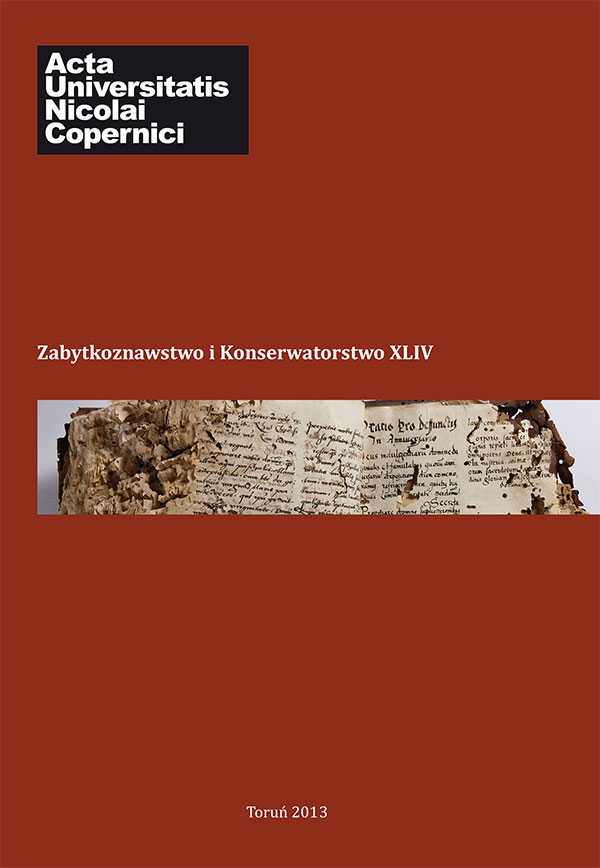Veraicon w średniowiecznym Toruniu
DOI:
https://doi.org/10.12775/AUNC_ZiK.2013.003Słowa kluczowe
sztuka Torunia, Toruń, veraicon, średniowieczeAbstrakt
The subject of the analysis are the images of the Faces of Jesus: wall paintings, from around 1350–1360, from the tenement house at 17/19 Żeglarska Street, 1-st floor, currently plastered – (A), and wall paintings from St. Jacob’s Church ,1390, the presbytery (the eastern wall and the vault) – (B).
The article presents the origin of the legend, historical message and the iconographic tradition of “archeiropoietos” images – not made by a human hand. The article describes and presents the oldest eastern tradition which created the iconographic canon of Mandylion image (Glorious Face of Jesus Christ). The study also contains ideological content connected, in the East, with this type of image. The article also analyses the formation of the western type of Veraicon, emphasising assimilation and conversion of legends and iconography taken from the East. The study indicates changes which led to the creation of the passion Face of Jesus. Different variations of Veraicon were discussed with the emphasis on the lack of one canonical representation in western art. New ideological content was stressed including the image of the Face of Jesus Christ in western art.
The article linked the representations A and B with adequate variants of the Face of Jesus appearing in Europe.
Concluding, it should be stated that, in the insignificant time and space gap, on the territory of Toruń (Old Town and New Town), two different types of the Real Face of Jesus – Veraicon – were applied. The first of them (image A – 17/19 Żeglarska Street) represents a very early type in the western tradition, the second one (the image B, St. Jacob’s Church) – The Face on the Veil held by Angels represents transformations of the form and the ideological content taking place in the art of the West.
As long as the image A may be connected with adoration and bigotry (rather of private nature), the second image B is connected with public altar liturgy.
Each type of the image, representing a different variant of Veraicon, was selected to perform a different function.
Pobrania
Opublikowane
Jak cytować
Numer
Dział
Licencja
CC BY ND 4.0. Posiadaczem prawa autorskiego (Licencjodawcą) jest Autor, który na mocy umowy licencyjnej udziela nieodpłatnie prawa do eksploatacji dzieła na polach wskazanych w umowie.
- Licencjodawca udziela Licencjobiorcy licencji niewyłącznej na korzystanie z Utworu/przedmiotu prawa pokrewnego w następujących polach eksploatacji: a) utrwalanie Utworu/przedmiotu prawa pokrewnego; b) reprodukowanie (zwielokrotnienie) Utworu/przedmiotu prawa pokrewnego drukiem i techniką cyfrową (e-book, audiobook); c) wprowadzania do obrotu egzemplarzy zwielokrotnionego Utworu/przedmiotu prawa pokrewnego; d) wprowadzenie Utworu/przedmiotu prawa pokrewnego do pamięci komputera; e) rozpowszechnianie utworu w wersji elektronicznej w formule open access na licencji Creative Commons (CC BY-ND 3.0) poprzez platformę cyfrową Wydawnictwa Naukowego UMK oraz repozytorium UMK.
- Korzystanie przez Licencjobiorcę z utrwalonego Utworu ww. polach nie jest ograniczone czasowo ilościowo i terytorialnie.
- Licencjodawca udziela Licencjobiorcy licencji do Utworu/przedmiotu prawa pokrewnego nieodpłatnie na czas nieokreślony
PEŁEN TEKST UMOWY LICENCYJNEJ >>
Statystyki
Liczba wyświetleń i pobrań: 392
Liczba cytowań: 0



